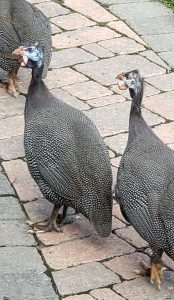
 Who wouldn’t love a robotic vacuum cleaner that would remove ticks from the lawn? An organic Roomba! Apparently, that is just what Guinea fowl are touted to be. In order to gain further insight into this, we talked to Gardiner resident, Tom McMahon.
Who wouldn’t love a robotic vacuum cleaner that would remove ticks from the lawn? An organic Roomba! Apparently, that is just what Guinea fowl are touted to be. In order to gain further insight into this, we talked to Gardiner resident, Tom McMahon.
Tom says, “The tick population was so thick that walking from the office to my shop was like navigating a minefield—I could literally see them teeming on the ground.” Tom’s home and business, McMahon’s Contracting, share a 10-acre parcel on Bruynswick Road, so he had to make this fearsome commute daily.
Fearing the dreaded Lyme disease, but looking for a non-toxic solution, he read about Guinea fowl being tick eating machines. “That’s the ticket,” he thought, “After all, I’ve raised chickens, right? How hard could it be?” Seven years later, Tom reports that, “The only similarity between raising chickens and raising guinea fowl is that they are both birds that live in a coop and require feed and water.”
He started with 15 adult guineas from a local farm/rescue operation and was told to keep them in the coop for two to three weeks, feeding them daily and talking to them to get them acclimated. Then it would be safe to “let them out to free range and do their job: tick eating.”
This sounds simple enough, but Tom laughed. “You’d think so, but on the 21st day they wouldn’t go back into the coop at the end of the day. There are foxes, coyotes, hawks, eagles, fisher cats, and raccoons around my place that would love a guinea meal, so I tried to encourage them to go into the coop. At some point, I found myself chasing them around the yard, and it was at that point they flew into the trees, never to be seen again.” Lesson #1: “Never chase a guinea fowl.”
Tom did not give up. So what happened next? “Well, I got more birds,” Tom said, “this time teenagers, so after learning Lesson #1, I found that making a loud show of putting feed in their feeders at the end of the day and walking very slowly behind them, clapping my hands gently, would encourage them to move in the direction of the coop door.
Sometimes they’d go right in, but there is often a rogue bird who will walk past the door, and repeatedly back and forth eternally, never tiring and never entering. But I found that having another person stand about 10 feet away on the far side of the coop door, arms wide, while I gently moved them towards it, works. Usually.”
At that point, Tom thought he was home free, and heading for tick free, but there were more lessons to learn. The next came after he had successfully raised a dozen guinea keets (baby guineas) to adulthood. “There is always a pecking order with birds, and through the ranks rose a dominant male that I called Knobby, because he had an additional knob atop the traditional bony head ridge. I liked Knobby. He was a benevolent despot, kind to his hens and gentle in how he managed the entire flock.”
A year later though, another male rose through the ranks and challenged Knobby repeatedly, until one day Knobby just disappeared. The new leader earned himself the name “Attila” because he was so ruthless and mean to the hens and the other males.
Tom realized he should have immediately “put him into the pot” when he found one of the hens so bloodied that he cornered Attila, yelled at him, and then left him alone in the coop all day. The next day, when the flock was let out, Attila jumped out the door, looked over his shoulder as if to say, “Follow me!” and half the flock followed him into the woods, never to be seen again. Lesson #2: “Never yell at a guinea.”
With some trepidation we asked if there were any other lessons we should know about. Tom replied, “Let me think; OK there’s the noise. That, I’ve gotten used to, but when we have company… Lesson #3: If it’s too noisy, move the party not the birds.
Apparently there is one final lesson. Tom says it’s important to acknowledge that these birds have a dangerous job to do out in the open, and he stopped having memorials for them the third time he found a pile of feathers on the ground.
Lesson #4: Be resolved that every year, a free ranging flock loses about 40% through predation.
If you can manage these four piece-of-cake lessons, consider this: Tom McMahon’s dogs used to come in covered in ticks. So far, in 2019, he’s found maybe two.
